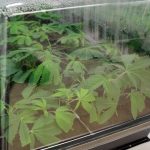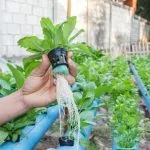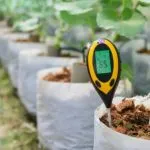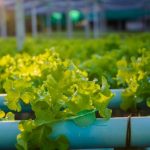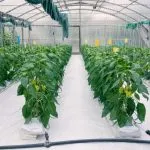Hydroponics has revolutionized the way we grow plants, offering a soil-less alternative and providing exceptional control over the growing environment. One crucial aspect when cultivating plants in a hydroponic system is maintaining the ideal air temperature. Understanding the significance of the air temperature for hydroponics will help you optimize growth conditions and ensure a thriving garden.
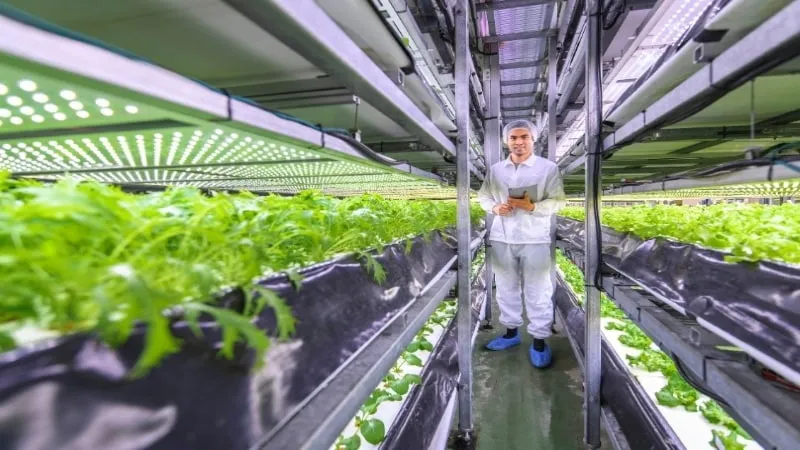
The ideal air temperature for hydroponics varies depending on the type of plant you’re growing; however, a general range can work for most plants. As a gardener, you should aim to maintain the air temperature between 62 and 72 degrees Fahrenheit (17 to 22 degrees Celsius) within your hydroponic system. This range encourages healthy growth and minimizes the risk of disease or stress on your plants. To achieve optimal plant growth, it’s also important to monitor and adjust humidity levels as needed. With the right balance of temperature and humidity, your hydroponic garden will flourish, yielding impressive results.
- Importance of Ideal Air Temperature for Hydroponics
- Proper Air Temperature Ranges for Different Plant Types
- Factors Affecting Air Temperature in Hydroponic Systems
- Strategies for Maintaining Ideal Air Temperature
- Water Temperature and Nutrient Solution Management
- Monitoring and Adjusting Hydroponic Temperatures
- Frequently Asked Questions
Importance of Ideal Air Temperature for Hydroponics
Plant Growth and Development
When setting up your hydroponics system, maintaining the ideal air temperature is crucial for promoting healthy plant growth and development. Most plants thrive in an air temperature range of 65-75°F (18.3-23.8°C). This ‘comfort zone’ is suitable for a majority of popular plant types, while some plants like lettuce, strawberries, and alstroemeria prefer lower temperatures, and tomatoes and cucumbers do better near 75°F. It’s essential to determine the optimum temperature for your specific crops to ensure successful growth.
Oxygen Levels and Photosynthesis
Your hydroponics system’s air temperature has an indirect impact on oxygen levels in the water, which plays a vital role in plant growth through photosynthesis. When water temperatures are within the ideal range, the dissolved oxygen in water increases, enhancing the plants’ ability to produce energy. If the air temperature is too high, water temperature increases and oxygen levels can decrease, leading to stress on your plants and potentially stunted growth. Keeping air temperature in the appropriate range will support efficient photosynthesis and overall plant health.
Preventing Pathogens and Algae
In addition to affecting plant growth, the air temperature in your hydroponics system is critical in preventing the growth of pathogens and mold. High humidity and warm temperatures can create the perfect environment for mold, fungi, and pests to thrive. By maintaining the proper air temperature, you can keep humidity under control, reducing the risk of mold and pathogens harming your plants. This is one of the best natural ways to prevent algae growth as well.
Respiration
Plants require a balanced environment to maintain proper respiration rates, which helps them produce energy and release waste products efficiently. Excessive heat or cold can disrupt these processes, stressing your plants.
Some key points to remember:
- The ideal air temperature for most plants in hydroponics is between 65-75°F (18.3-23.8°C)
- Proper air temperature supports healthy plant growth, oxygen levels, and photosynthesis
- Maintaining the right temperature can help prevent the growth of pathogens and mold in your hydroponics system.
Proper Air Temperature Ranges for Different Plant Types
Taking into account the ideal air temperature is essential for successful hydroponic gardening. As you manage your grow room, you may wonder, “What temp should my grow room be?” The optimal temperature varies for different types of plants. In this section, we will discuss the ideal air temperature ranges for lettuce and leafy greens, tomatoes, cucumbers, and other fruiting plants, and strawberries and other berries.
Lettuce and Leafy Greens
For hydroponic lettuce and similar leafy greens, the ideal air temperature range is between 68 and 72 degrees Fahrenheit. These plants need cooler temperatures and won’t tolerate extended periods above 80 degrees Fahrenheit. While managing your grow room, ensure consistent temperatures to keep your lettuce and leafy greens thriving.
Tomatoes, Cucumbers, and Other Fruiting Plants
Tomatoes, cucumbers, and other fruiting plants generally require warmer temperatures for optimal growth. Aim for the following temperature ranges:
- Day: 75 to 85 degrees Fahrenheit
- Night: 60 to 65 degrees Fahrenheit
These plants can tolerate up to 90 degrees Fahrenheit but should not be exposed to extreme temperatures for prolonged periods. Keep your grow room’s temperature stable within this range to maintain the health and productivity of your fruiting plants.
Strawberries and Other Berries
For hydroponic strawberries and similar berry plants, the ideal air temperature range lies between 70 and 78 degrees Fahrenheit. These plants also require a considerable drop in temperature at night, around 10 degrees lower than daytime temperatures. Provided that you maintain the appropriate day and night temperature fluctuations, your berries will grow and flourish.
Factors Affecting Air Temperature in Hydroponic Systems
Lighting and Heat Production
To control the air temperature in your hydroponic system, you need to consider the type of lighting and heat produced by your setup. Different lighting systems produce varying amounts of heat, which can impact the air temperature. For example, high-intensity discharge (HID) lights tend to emit more heat compared to LED lights. It’s essential to monitor the heat generated by your lighting system and adjust it accordingly to keep the air temperature within the desired range.
Humidity and Ventilation
Humidity plays a significant role in influencing the air temperature in hydroponic systems. Higher humidity levels can make it more difficult for your plants to maintain their ideal temperature range. To lower humidity, pay attention to the ventilation system in your grow room. Proper ventilation allows for better air circulation, preventing humidity build-up and maintaining optimal air temperature. You can use exhaust fans, air filters, and vents to ensure that your plants receive enough fresh air and maintain a balanced humidity level. Adjust the ventilation based on your specific plant requirements and environmental conditions.
Surrounding Environmental Conditions
Keep in mind that the surrounding environmental conditions will also affect the air temperature in your hydroponic system. If you’re growing hydroponic plants outdoors then external factors such as weather and location can impact your system’s climate. Make sure to monitor and adjust the room temperature and consider using insulation or shading techniques to protect your plants from external temperature fluctuations and too much sunlight.
Strategies for Maintaining Ideal Air Temperature
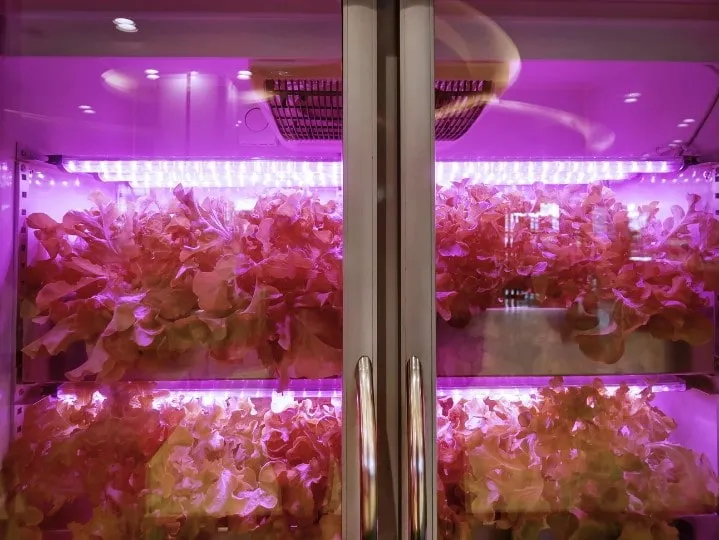
Air Conditioning and Ventilation System
To maintain the ideal air temperature for your hydroponics system, you’ll want to invest in an air conditioning and ventilation system. This will help you regulate the temperature and keep it between 65-75°F (18.3-23.8°C), which is beneficial for most plants.
Choose an efficient air conditioning system that is suitable for the size of your grow room. Invest in reliable ventilation to promote proper airflow, promptly remove excess heat and moisture, and avoid any build-up of pests or diseases.
Evaporative Cooling and Airflow
Another effective way to maintain the ideal temperature in your hydroponic setup is by using evaporative cooling. Evaporative coolers work by using water to absorb heat, which in turn, cools the air and increases humidity in a grow tent. To make the most of this, ensure your system is set up properly and that water is circulating uniformly.
On top of this, promoting adequate airflow in your hydroponic setup is vital. Use oscillating fans to increase air circulation and prevent hotspots or stagnant air within your grow area. This will help maintain an even temperature throughout the space, providing your plants the ideal environment to flourish.
Find out about some more methods on how to keep the temp down in a grow tent.
Insulation and Heat Stress Prevention
You will also need to know how to increase the temperature in your grow tent in winter. Once you add heat, ensuring that your grow space is well insulated will not only help maintain proper air temperature but also prevent heat stress on your plants. Insulation can be achieved through walls, floors, and ceilings, as well as by utilizing shading devices and reflective materials in your grow rooms.
Heat stress can cause a variety of issues, such as wilted, yellowing leaves, and reduced growth. To avoid this, monitor the temperature regularly and adjust your cooling systems as needed. Remember, prevention is key to ensuring the healthy and productive growth of your hydroponic plants. We explain this further in our guide about hydroponic plants wilting.
Water Temperature and Nutrient Solution Management
Managing your water temperature and nutrient solution is an important aspect of hydroponic gardening. The ideal water temperature for hydroponics varies depending on what type of plants you’re growing. Generally, the optimum temperature range is between 60° F and 75° F. For example, lettuce and strawberries prefer the lower end of the range, while tomatoes and cucumbers thrive near 75° F.
A critical factor to consider is the dissolved oxygen in the water. Higher water temperatures can lead to lower dissolved oxygen levels, which can negatively impact your plants’ ability to absorb nutrients and carry out respiration. By maintaining your water temperature within the ideal range, you can ensure a healthy level of dissolved oxygen for your plants.
To help control the water temperature in your hydroponic system, consider using a chiller, especially during hot weather or in warmer climates. A chiller can help maintain a consistent water temperature, ensuring optimum plant growth and preventing issues related to fluctuating temperatures.
Along with maintaining proper water temperature, managing your nutrient solution is crucial for successful hydroponic gardening. Regularly check and adjust nutrient levels to provide your plants with the ideal growing conditions. Additionally, keep the nutrient solution at a steady temperature of 70 to 78 degrees Fahrenheit for the best results.
Monitoring and Adjusting Hydroponic Temperatures
Measurement Tools and Thermometers
To ensure optimal growth and health of your hydroponic plants, it’s important to monitor the air and water temperatures regularly. Accurate temperature measurement is essential, so invest in a reliable thermometer. Digital thermometers and temperature probes are effective tools for measuring temperatures in different areas of the hydroponic system. For a comprehensive view of the environment, combine these tools with humidity monitors to keep an eye on your relative humidity levels.
Controllers and Automation
As a hydroponic grower, you may want to consider investing in temperature controllers and automation systems. These devices can help maintain ideal temperatures in your grow environment by adjusting heating, cooling, and ventilation equipment. This type of automation not only helps spare you some effort but also ensures consistent temperature throughout the day and night.
Some temperature controllers even come with built-in humidity sensors, which can help automate humidity levels, providing better environmental control for your plants.
Fine-Tuning for Specific Plants and Growth Stages
Different plant species and growth stages require specific temperature and humidity ranges to thrive. Here are some general guidelines for ideal atmospheric temperatures in a hydroponic system:
- Cuttings & Seedlings: 68ºF to 77ºF (20ºC to 25ºC)
- Lettuce and Strawberries: lower end, near 40°F (4°C)
- Tomatoes, Cucumbers, and Cannabis: best near 75° F (24°C)
It’s essential to research your chosen plants’ specific temperature and humidity requirements. Adjusting the environment according to their needs and growth stages will improve their health and increase productivity.

